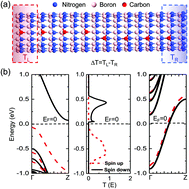Spin-dependent Seebeck effect, and spin-filtering and diode effects in magnetic boron–nitrogen nanotube heterojunctions
Abstract
The spin-Seebeck effect (SSE) has long been considered as an effective route to generate pure spin currents by using a temperature gradient in magnetic materials. By substituting some boron or nitrogen atoms with carbon atoms in boron–nitrogen nanotubes (BNNTs), we constructed some magnetic BNNT heterojunctions, and found that spin-dependent currents with opposite flow directions can be driven through the heterojunction by using a temperature gradient, supporting that a promising SSE occurs in these nanotube-based devices. The spin polarization of the thermal spin-dependent currents is up to 70% at room temperature, and the rotational symmetry of carbon substitutions in the central scattering region influences the thermal charge and spin currents significantly. A negative differential resistance effect induced by the competition between the temperature gradient and the spin thermopower is also uncovered. Besides, spin-filtering and spin-dependent diode effects induced by a bias voltage are also observed in the BNNT heterojunctions. These theoretical results give us deep understanding of how spin currents are driven in magnetic nanotube-based heterojunctions, and provide us with a feasible route to design spin caloritronic devices based on nanotube structures.



 Please wait while we load your content...
Please wait while we load your content...